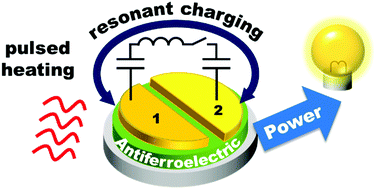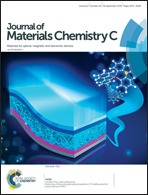Combining inverse and conventional pyroelectricity in antiferroelectric thin films for energy conversion†
Abstract
Pyroelectric materials are promising for thermal energy scavenging from waste-heat sources and new materials with exotic properties are constantly being discovered. Antiferroelectrics (AFE) are of particular interest since such materials have been observed to possess both conventional, negative pyroelectricity and inverse, positive pyroelectricity. In this study, we compare direct and indirect measurements of the pyroelectric coefficient and use the temperature dependence on the dielectric constant to show the inverse pyroelectric regime arises primarily from field-induced pyroelectricity. Energy conversion cycles are performed in both pyroelectric regimes using a 1 kHz pulsed laser heat source, realizing a maximum power density of 2.25 W cm−3 in the conventional regime and 0.68 W cm−3 in the inverse regime. A new pyroelectric energy conversion model, using parameters taken from direct measurements of the pyroelectric coefficient, capacitance, loss tangent, and leakage current agrees with the energy conversion experiments, showing both the validity of the model and the origin of pyroelectricity in the inverse regime. Finally, a resonant circuit for pyroelectric energy harvesting is proposed that takes full advantage of the bi-directional functionality of AFE materials. This work clarifies the debate on the origin of pyroelectric features in AFE materials and demonstrates the potential for future energy conversion applications.



 Please wait while we load your content...
Please wait while we load your content...